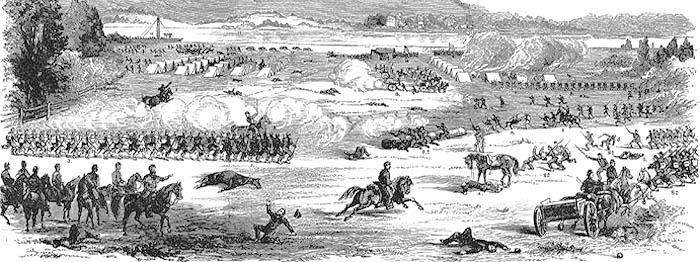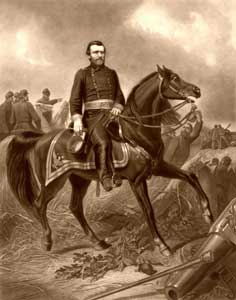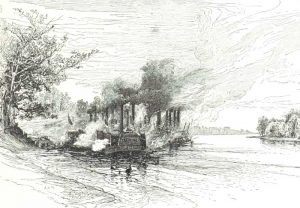
Civil War Battle of Belmont, Missouri.
The Federal victory in the Western Theater of the Civil War was accomplished through combined army and navy operations on land and water.
Combined operations between land and water forces emerged first on the Lower Ohio River mainly because the Army had unified command over land and river forces for the first year and a half of the war.
The shared philosophies and goals of Union Generals Ulysses S. Grant and William Sherman with Rear Admiral David Porter resulted in the reopening of the Mississippi River. In 1861, early gunboats scouted Confederate positions and intimidated any Confederate forward movement beyond Columbus, Kentucky, or the Tennessee border. Gunboats quickly carried raiding parties to any desired point, and covering fire paved the way for overland movements.
On November 6, 1861, Brigadier General U.S. Grant and his men left Cairo, Illinois, by steamers, in conjunction with two gunboats, to make a demonstration against the Confederate stronghold at Columbus, Kentucky.
However, the following day, Grant learned that Confederate troops had crossed the Mississippi River from Columbus to Belmont, Missouri, to intercept two detachments sent in pursuit of Brigadier General M. Jeff Thompson and, possibly, to reinforce Major General Sterling Price’s force.
Battle of Belmont, Missouri – November 7, 1861
When General Grant and his men landed on the Missouri shore, out of the range of Confederate artillery at Columbus, they started marching one mile to Belmont. At 9:00 in the morning, the Union troops overran the surprised Confederate camp and destroyed it. The Federals then destroyed the Rebel supplies and equipment they found because they did not have the means to carry them off. However, the scattered Confederate forces reorganized and received reinforcements from Columbus.
Counterattacked by the Confederates, the Union force withdrew, re-embarked, and returned to Cairo. Grant did not accomplish much in this operation, but at a time when little Union action occurred anywhere, any activity heartened many, and the engagement received considerable attention in the press.
Gunboat fire enabled the threatened Federal forces to withdraw intact from Belmont, Missouri. The battle technically resulted in a Union victory with 498 Union casualties and 966 Confederates. However, the Confederates viewed Belmont as a Southern victory since Grant had staged an attack and been driven off.
This battle was the first combat test of General Ulysses S. Grant, the future Union Army General-in-Chief and eventual U.S. President.
Compiled and edited by Kathy Alexander/Legends of America, updated June 2023.
Also See:
Civil War Timeline & Leading Events
Sources:
National Park Service Battle Summaries
National Register of Historic Places Nomination
Wikipedia


